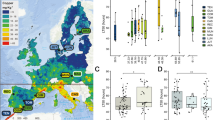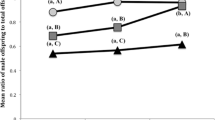Abstract
We aimed to identify genetic variation in the response of reproductive behaviors to lead (Pb2+) exposure. We reared a subset of the Drosophila Genetic Reference Panel (DGRP) inbred lines on control or Pb-treated (500 μM PbAc) medium and tested for differences in copulation latency, copulation duration, and fecundity. Pb exposure decreased fecundity (p < 0.05) and increased copulation duration (p < 0.05) across DGRP lines. We found intraspecific genetic variation in latency, duration, and fecundity in both control and Pb-treated flies, with heritability ranging from 0.45 to 0.80. We found a significant genotype-by-environment interaction for copulation duration (p < 0.05). Genetic correlation matrices revealed significant genetic variation in common between control and Pb-treated flies for each trait (p < 0.05). Our results indicate that intraspecific genetic variation plays a role in Pb susceptibility and emphasize the importance of considering the impacts of variation in susceptibility to Pb pollution.


Similar content being viewed by others
References
Abolaji AO, Kamdem JP, Farombi EO, Rocha JBT (2013) Drosophila melanogaster as a promising model organism in toxicological studies. Arch Bas App Med 1:33–38
Beeby A (1991) Toxic metal uptake and essential metal regulation in terrestrial invertebrates: a review. In: Newman MC, McIntosh AW (eds) Metal ecotoxicology: concepts & applications. Lewis Publishers, Chelsea.
Burke MK, Rose MR (2009) Experimental evolution with Drosophila. Am J Physiol Reg Integrat Comp Physiol 296:R1847–R1854
Demayo A, Taylor MC, Taylor KW, Hodson PV, Hammond PB (1982) Toxic effects of lead and lead compounds on human health, aquatic life, wildlife plants, and livestock. CRC Crit Rev Environ Contr 12:257–305
Eisler R (1988) Lead hazards to fish, wildlife, and invertebrates: a synoptic review. US Fish and Wildlife Service, US Department of Interior. Biol Rep 85 (1.14): Contam Haz Rev Report No. 14
Gundacker C, Gencik M, Hengstschläger M (2010) The relevance of the individual genetic background for the toxicokinetics of two significant neurodevelopmental toxicants: mercury and lead. Mut Res 705:130–140
Hegmann JP, Possidente B (1981) Estimating genetic correlations from inbred strains. Behav Genet 11:103–114
Hirsch HVB, Mercer J, Sambaziotis H, Huber M, Stark DT, Torno-Morley T, Hollocher K, Ghiradella H, Ruden DM (2003) Behavioral effects of chronic exposure to low levels of lead in Drosophila melanogaster. Neurotoxicology 24:435–442
Hirsch HVB, Possidente D, Averill S, Palmetto Despain T, Buytkins J, Thomas V, Goebel WP, Shipp-Hilts A, Wilson D, Hollocher K, Possidente B, Lnenicka G, Ruden DM (2009) Variations at a quantitative trait locus (QTL) affect development of behavior in lead-exposed Drosophila melanogaster. Neurotoxicology 30:305–311
Hirsch HVB, Lnenicka G, Possidente D, Possidente B, Garfinkel MD, Wang L, Lu X, Ruden DM (2012) Drosophila melanogaster as a model for lead neurotoxicology and toxicogenomics research. Front Gen 3:1–7
Huang W, Massouras A, Inoue Y, Peiffer J, Ràmia M et al (2014) Natural variation in genome architecture among 205 Drosophila melanogaster Genetic Reference Panel Lines. Genome Res 24:1193–1208
Little EE (1990) Behavioral toxicology: stimulating challenges for a growing discipline. Environ Tox Chem 9:1–2
Mackay TFC, Richards S, Stone EA, Barbadilla A, Ayroles JF et al (2012) The Drosophila melanogaster Genetic Reference Panel. Nat 482:173–178
Manier MK, Belote JM, Berben KS, Novikov D, Stuart WT, Pitnick S (2009) Resolving mechanisms of competitive fertilization success in Drosophila melanogaster. Science 328:354–357
Markow TA, O’Grady P (2008) Reproductive ecology of Drosophila. Funct Ecol 22:747–759
Peterson EK, Long HE (2018) Experimental protocol for using Drosophila as an invertebrate model system for toxicity testing in the laboratory. JoVE 137:e57450
Peterson EK, Wilson DT, Possidente B, Possidente D, McDaniel P, Morley E, Possidente D, Hollocher KT, Ruden DM, Hirsch HVB (2017) Lead (Pb2+) accumulation, elimination, sequestration, and genetic variation within and between generations in a model system, Drosophila melanogaster. Chemosphere 181:368–375
Peterson EK, Yukilevich R, Kehlbeck J, LaRue KM, Ferraiolo K, Hollocher K, Hirsch HVB, Possidente B (2017) Asymetrical positive assortative mating induced by developmental lead (Pb2+) exposure in a model system Drosophila melanogaster. Curr Zool 63(2):195–203
Rand MD (2010) Drosophotoxicology: the growing potential for Drosophila in neurotoxicology. Neurotoxicol Teratol 32:74
Rubin GM, Yandell MD, Wortman JR, Gabor Miklos GL, Nelson CR et al (2000) Comparative genomics of the eukaryotes. Science 287:2204–2215
Turiegano E, Mondero I, Pita M, Torroja L, Canal I (2012) Effect of Drosophila melanogaster female size on male mating success. J Insect Behav 26:89–100
White LD, Cory-Slechta DA, Gilbert ME, Tiffany-Castiglioni E, Zawia NH, Virgolini M, Rossi- George A, Lasley SM, Qian YC, Riyaz Basha M (2007) New and evolving concepts in the neurotoxicology of lead. Toxicol Appl Pharmac 225:1–27
Williamson P, Evans PR (1972) Lead: levels in roadside invertebrates and small mammals. Bull Environ Contam Toxicol 8:280–288
Zhou S, Morozova TV, Hussain YN, Luoma SE, McCoy L, Yamamoto A, Mackay TFC, Anholt RRH (2016) The genetic basis for variation in sensitivity to lead toxicity in Drosophila melanogaster. Environ Health Perspect 124:1062–1070
Acknowledgements
This work was supported by funding from the Department of Biological Sciences (University at Albany-State University of New York) and the Department of Biology (Skidmore College). We would like to thank Dr. Gregory Lnenicka (Department of Biological Sciences, University at Albany-State University of New York), Dr. David Lawrence (Department of Environmental Health Sciences, University at Albany-State University of New York), Dr. Robert Osuna (Department of Biological Sciences, University at Albany-State University of New York) and Dr. Roman Yukilevich (Department of Biology, Union College) for their advice and support throughout the development, implementation and writing of this research. We would also like to thank Lindsay Bouchard, Julie Kappil, and Mark Waterhouse for their assistance during mating or fecundity assays.
Author information
Authors and Affiliations
Corresponding author
Ethics declarations
Conflict of interest
The authors have no conflicts of interest to report.
Rights and permissions
About this article
Cite this article
Peterson, E.K., Possidente, B., Stark, A. et al. Intraspecific Genetic Variation for Lead-Induced Changes in Reproductive Strategies. Bull Environ Contam Toxicol 103, 233–239 (2019). https://doi.org/10.1007/s00128-019-02650-w
Received:
Accepted:
Published:
Issue Date:
DOI: https://doi.org/10.1007/s00128-019-02650-w




